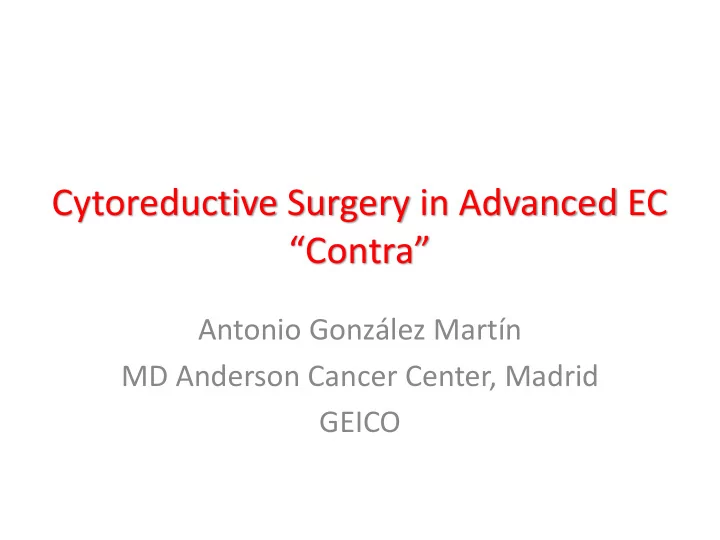

Cytoreductive Surgery in Advanced EC “Contra” Antonio González Martín MD Anderson Cancer Center, Madrid GEICO
Surgery in endometrial cancer Zanfagnin…and Andrea Mariani. Expert review of anticancer therapy 2016
Retrospective evidence for maximal cytoreduction in EC (I) Author Stage and histology Median OS Median OS optimal non-optimal Goff 47 pts 19 months 8 months Gyn Oncol Stage IV 1994 29 complete resection Bristow 65 pts Stage IVB 34 months 11 months Gyn Oncol Optimal (RD < 1 cm) in 55% 2000 Endometrioid 34%, serous 32% Tanner 44 pts 52 months 8.6 months Gyn Oncol IIIC-IV carcinosarcoma 2011 Optimal = complete resection Thomas 70 Pts 51 months 12 months Gyn Oncol IIIC-IV serous 2007 Optimal = complete resection
Cytoreductive surgery for advanced or recurrent endometrial cancer: A meta-analysis • 14 retrospective cohorts, 672 patients • Huge Heterogeneity – definition of “optimal”: < 2 cm (3 studies) vs < 1 cm (7 studies) vs no-gross residual (4 studies) – primary surgery (10 studies) vs for recurrent disease (4 studies) – Histology in primary surgery : 5 studies only UPSC and 5 studies included all histologies – Only data of adjuvant therapy in 12 studies • OS associuated with complete surgical cytoreduction (each 10% increase improving survival by 9.3 months, p=0.04) Joyce N. Barlin, Isha Puri , Robert E. Bristow. Gynecol Oncol 2010
Retrospective evidence for maximal cytoreduction in EC (II) Author Stage and histology Median OS Median OS optimal non-optimal Alagkiozidis 168 pts 25 months 13 months Int J Surg Stage III-IV 2015 54 carcinosarcoma R0 64% 21 months 9 months 54 serous/clear Cell R0 53% 22 months 12 months 60 endometrioid R0 68% 36 months 21 months
Limitation of current evidence for upfront surgery • Bias related to the retrospective nature of the data. • Lack of good evidence regarding the impact of histological subtype (type I vs Type II) and endometrioid molecular subtypes in the potential resectability and the outcome after complete resection. • Impact of adjuvant chemo/radiation therapy. • The rate of upfront complete cytoreduction is surgeon dependent.
Impact of surgical skills in outcome More mid and upper abdominal procedures performed (53% vs 69%) (omentectomy, peritonectomy, diaphragmatic resection and bowel resection) Alagkiozidis Int J Surg 2015
Neoadjuvant chemotherapy • Retrospective study • 44 patients with stage IV uterine serous carcinoma • 10 NACT followed by IS (interval surgery) vs 34 PCS (primary cytoreductive surgery) • Rates of debulking to no gross residual disease (70%NAC vs 32.3% PCS) or less than 1 cm of disease (30%NAC vs 50%PCS) • No difference in median PFS (10.4 vs 12months) or OS (17.3 vs 20.7 months) for NAC and PCS. Wilkinson-Ryan ey al. Int J Gyn Cancer 2015
Patterns of recurrence in EC Zanfagnin…and Andrea Mariani. Expert review of anticancer therapy 2016
Factors for considering surgery in recurrent EC • Site of recurrence • Duration of the disease-free period • General medical condition – Performance status – Co-morbidities • Prior adjuvant treatment (radiotherapy, chemotherapy, or both)
Indications of surgery in recurrent EC Isolated vaginal or pelvic recurrence and a history of radiotherapy, Recommendation is supported by only low-level evidence. Zanfagnin…and Andrea Mariani. Expert review of anticancer therapy 2016
Indications of surgery in recurrent EC If surgery is performed for recurrent EC the aim should be macroscopic complete resection, but there is a lack of prospective evidence Zanfagnin…and Andrea Mariani. Expert review of anticancer therapy 2016
Conclusion • There is a lack of prospective evidence regarding the value of cytoreductive surgery in advanced endometrial cancer. • Individual decisions should be made on the basis of performance status and clinical situation of the patient, surgical risks and skills, and histological subtype. • Neoadjuvant chemotherapy followed by interval surgery merit further investigation. • GCIG is an excellent network for leading a surgical trial in advanced endometrial cancer.
Thank you
Recommend
More recommend